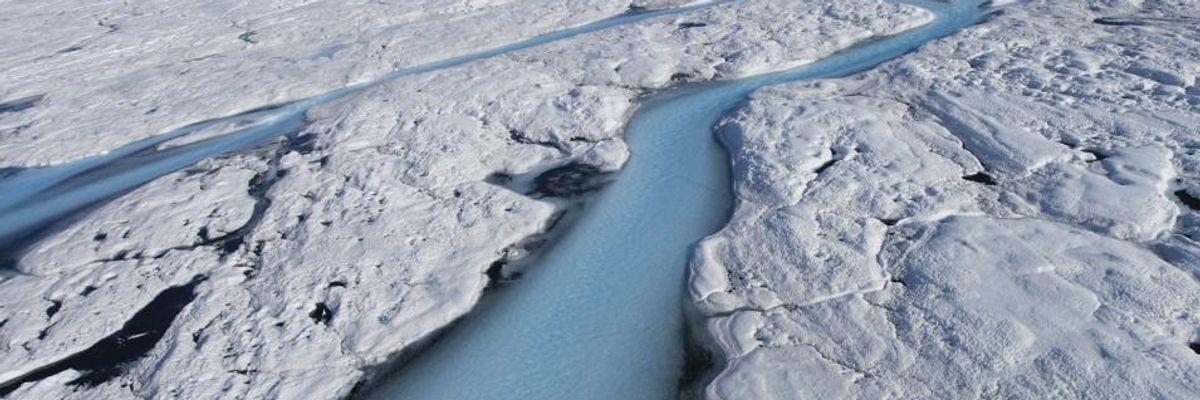
New research finds that Greenland's ice sheet is melting even in the middle of winter. (Photo: Patrick Robert/Corbis)
Greenland's Rapid Ice Melt Persists Even in Winter, Study Finds
"Greenland is a bit like a sleeping giant that is awakening. Who knows how it will respond to a couple of more degrees of warming?"
In the latest troubling study regarding how the climate crisis is affecting the world's iciest regions, a new report by the Scottish Association for Marine Science (SAMS) found that the second-largest ice sheet in the world is currently melting even in winter.
The study follows a report released earlier this month showing that Greenland's ice melt rate is currently faster than it's been in about 7,000 years. The island's 650,000 cubic miles of ice is melting 50 percent faster than it did in pre-industrial times.
" Greenland is a bit like a sleeping giant that is awakening," Edward Hanna, a climate scientist at the University of Lincoln, told Inside Climate News this week. "Who knows how it will respond to a couple of more degrees of warming? It could lose a lot of mass very quickly."
"Greenland is a bit like a sleeping giant that is awakening. Who knows how it will respond to a couple of more degrees of warming? It could lose a lot of mass very quickly." --Edward Hanna, University of Lincoln
The ice sheet's persistent melting even in winter has come about because huge waves below the surface of the Atlantic Ocean, created by unusually strong winter winds, are pushing warm water up to Greenland--creating an environment that's hostile for the country's icy ecosystem, explains SAMS.
These "coastally trapped internal waves" are "pushing warm water into the fjord and towards the glacier, causing melting hundreds of metres below the ocean surface," Dr. Neil Fraser, an ocean physicist who led the study, told the BBC.
Greenland's huge ice sheet also makes it a huge contributor to rising sea levels, SAMS noted, accounting for more than 20 percent of the annual increase in sea levels.
Accelerating, year-round run-off that persists even in the coldest months of the year is "the greatest contributor to sea level rise," Sarah Das, a researcher at Woods Hole Oceanographic Institution, told Inside Climate News.
An Urgent Message From Our Co-Founder
Dear Common Dreams reader, The U.S. is on a fast track to authoritarianism like nothing I've ever seen. Meanwhile, corporate news outlets are utterly capitulating to Trump, twisting their coverage to avoid drawing his ire while lining up to stuff cash in his pockets. That's why I believe that Common Dreams is doing the best and most consequential reporting that we've ever done. Our small but mighty team is a progressive reporting powerhouse, covering the news every day that the corporate media never will. Our mission has always been simple: To inform. To inspire. And to ignite change for the common good. Now here's the key piece that I want all our readers to understand: None of this would be possible without your financial support. That's not just some fundraising cliche. It's the absolute and literal truth. We don't accept corporate advertising and never will. We don't have a paywall because we don't think people should be blocked from critical news based on their ability to pay. Everything we do is funded by the donations of readers like you. Will you donate now to help power the nonprofit, independent reporting of Common Dreams? Thank you for being a vital member of our community. Together, we can keep independent journalism alive when it’s needed most. - Craig Brown, Co-founder |
In the latest troubling study regarding how the climate crisis is affecting the world's iciest regions, a new report by the Scottish Association for Marine Science (SAMS) found that the second-largest ice sheet in the world is currently melting even in winter.
The study follows a report released earlier this month showing that Greenland's ice melt rate is currently faster than it's been in about 7,000 years. The island's 650,000 cubic miles of ice is melting 50 percent faster than it did in pre-industrial times.
" Greenland is a bit like a sleeping giant that is awakening," Edward Hanna, a climate scientist at the University of Lincoln, told Inside Climate News this week. "Who knows how it will respond to a couple of more degrees of warming? It could lose a lot of mass very quickly."
"Greenland is a bit like a sleeping giant that is awakening. Who knows how it will respond to a couple of more degrees of warming? It could lose a lot of mass very quickly." --Edward Hanna, University of Lincoln
The ice sheet's persistent melting even in winter has come about because huge waves below the surface of the Atlantic Ocean, created by unusually strong winter winds, are pushing warm water up to Greenland--creating an environment that's hostile for the country's icy ecosystem, explains SAMS.
These "coastally trapped internal waves" are "pushing warm water into the fjord and towards the glacier, causing melting hundreds of metres below the ocean surface," Dr. Neil Fraser, an ocean physicist who led the study, told the BBC.
Greenland's huge ice sheet also makes it a huge contributor to rising sea levels, SAMS noted, accounting for more than 20 percent of the annual increase in sea levels.
Accelerating, year-round run-off that persists even in the coldest months of the year is "the greatest contributor to sea level rise," Sarah Das, a researcher at Woods Hole Oceanographic Institution, told Inside Climate News.
In the latest troubling study regarding how the climate crisis is affecting the world's iciest regions, a new report by the Scottish Association for Marine Science (SAMS) found that the second-largest ice sheet in the world is currently melting even in winter.
The study follows a report released earlier this month showing that Greenland's ice melt rate is currently faster than it's been in about 7,000 years. The island's 650,000 cubic miles of ice is melting 50 percent faster than it did in pre-industrial times.
" Greenland is a bit like a sleeping giant that is awakening," Edward Hanna, a climate scientist at the University of Lincoln, told Inside Climate News this week. "Who knows how it will respond to a couple of more degrees of warming? It could lose a lot of mass very quickly."
"Greenland is a bit like a sleeping giant that is awakening. Who knows how it will respond to a couple of more degrees of warming? It could lose a lot of mass very quickly." --Edward Hanna, University of Lincoln
The ice sheet's persistent melting even in winter has come about because huge waves below the surface of the Atlantic Ocean, created by unusually strong winter winds, are pushing warm water up to Greenland--creating an environment that's hostile for the country's icy ecosystem, explains SAMS.
These "coastally trapped internal waves" are "pushing warm water into the fjord and towards the glacier, causing melting hundreds of metres below the ocean surface," Dr. Neil Fraser, an ocean physicist who led the study, told the BBC.
Greenland's huge ice sheet also makes it a huge contributor to rising sea levels, SAMS noted, accounting for more than 20 percent of the annual increase in sea levels.
Accelerating, year-round run-off that persists even in the coldest months of the year is "the greatest contributor to sea level rise," Sarah Das, a researcher at Woods Hole Oceanographic Institution, told Inside Climate News.

